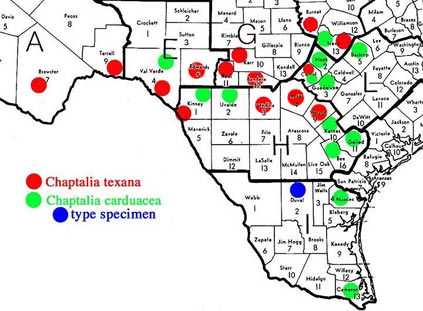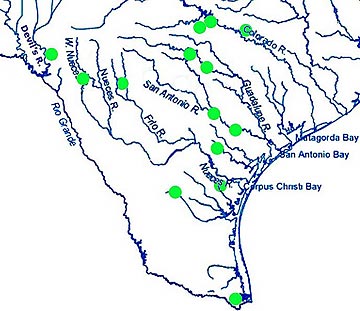

|

|
| C. texana & C. carduacea | C. carduacea & Rivers below the Central Gulf Coast |
|---|---|
| click map for larger views | |


|

|
| C. texana & C. carduacea | C. carduacea & Rivers below the Central Gulf Coast |
|---|---|
| click map for larger views | |
Within Texas the two species exhibit a pattern of overlapping but different ranges. Both occur in the southern and eastern Edwards Plateau, but from there C. carduacea extends southward into South Texas, where C. texana does not occur, while C. texana is found westward into the Trans-Pecos, where C. carduacea does not occur. In the study populations, although both occur in similar vegetation types, there seemed to be a clear difference in soil preference, with C. carduacea restricted to deeper soils (although shallow soils are common at that site) and C. texana the opposite. Scattered substrate data mentioned on herbarium specimens supported this potential difference but were not conclusive.
The extension of C. carduacea southward from Central Texas, when mapped against the major rivers of that region, especially along the rivers entering San Antonio Bay and Corpus Christi Bay, lead me to suspect a distribution defined by rivers which enter the Gulf of Mexico below the Central Gulf Coast (i.e., Colorado River south to the Rio Grande).
Nesom (1995) indicates a range for Chaptalia texana (which for him included C. carduacea) beyond Texas southward in Mexico to Jalisco, state of México, Puebla and Oaxaca (and with an outlier in Baja California Sur). All Chaptalia specimens from this region at TEX/LL, which has a very strong collection for northeastern Mexico, & UTEP were studied to see which represented either C. texana or C. carduacea. Although many specimens of C. texana in the narrow sense used in this study were found, none were found for C. carduacea.
Thanks to a loan of additional specimens from the U.S. Herbarium (US), it was determined that the type of C. leonina Greene (E. Palmer 764 from Monterrey, Nuevo León, Mexico) was referable to C. carduacea, as is one 1906 Monterrey specimen (C. G. Pringle 10169 US). The Monterrey locality shows that it may well occur in at least scattered form from extreme southern Texas across coastal plain of northern Tamaulipas southwestward to the base of the Sierra Madre Oriental in Nuevo León.
Google Earth plottings of C. texana and C. carduacea (including C. leonina) in Mexico:
View Chaptalia texana/C. carduacea in Mexico in a larger map